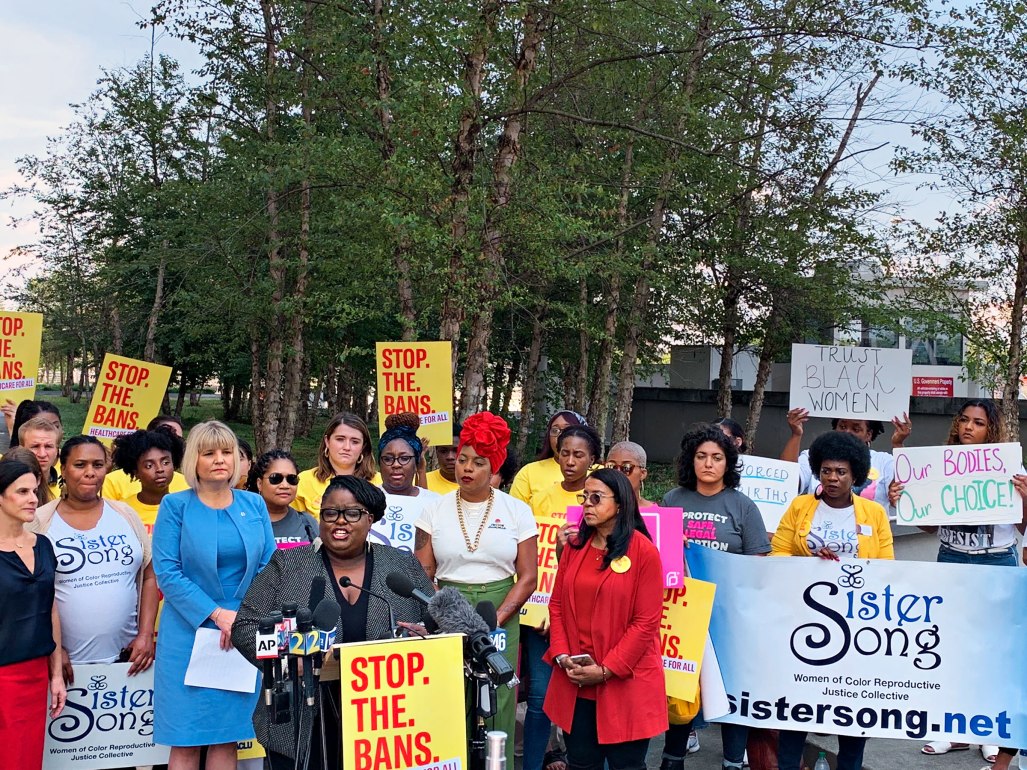Image via SisterSong.
Take Action
- Donate to BIPOC reproductive justice organizations SisterSong and the Afiya Center.
- Support EndoBlack, a Black-led organization supporting people of color diagnosed with endometriosis, and SisterLove, an organization that offers free HIV and other STI testing in Atlanta, Georgia, and Johannesburg, South Africa.
- Investigate legislation in your state and support the fight for reproductive justice.
On the evening of September 24th, the city of Montgomery made history by unveiling a new monument honoring three Black women for their unwilling role in the creation of modern gynecology (WSFA). Lucy, Anarcha, and Betsey are the only known names of eleven enslaved women experimented on without consent or anesthesia. Today, thanks to the gorgeous work of artist Michelle Browder, these women stand 15-feet tall, forever memorialized in steel and copper as the ‘Mothers of Gynecology.’
From the forced removal, kidnapping, and mass murder of Indigenous people, to the brutalization and sexual exploitation of enslaved Black people, white settler colonialists violated and attempted to eradicate people of color while constructing contemporary American society. As enslaved people had limited or nonexistent access to healthcare or bodily autonomy, available ‘care’ often involved involuntary medical experimentation (Health Equity). The “father of modern gynecology,” physician J. Marion Sims, performed agonizing surgical procedures on Lucy, Betsey, and Anarcha without consent — or anesthesia. Sims believed that Black people did not feel pain in the same way white people do. Half of white medical trainees still believe this today (AAMM). While Sims was celebrated for his discoveries, the women who suffered remained buried and largely forgotten until recently. It is Lucy, Betsey and Anarcha, along with countless others whose identities remain erased, to whom we owe inventions like the modern speculum and surgical techniques used to repair vesicovaginal fistulas (History).
During the unveiling of the sculptures, sculptor and community leader Browder stated, “The endeavor is to change the narrative as it relates to the history and how it’s portrayed regarding Sims and the women that were used as experiments. They’re not mentioned in any of the iconography or the information, the markers. And so I feel that if you’re going to tell the truth about this history, we need to tell it all” (Alabama).
The politicization of reproductive rights often centers abortion access, but reproductive health is a broader topic relating to bodily autonomy, a right that has been denied people of color for centuries. The latest abortion ban in Texas will most harshly affect marginalized BIPOC communities already struggling to escape poverty and gain access to health insurance and affordable birth control (Planned Parenthood).
A CDC report released earlier this year found that Black people are 3.3 times more likely than white people to die from pregnancy-related complications. Native American and Alaskan Native people are 2.5 times more likely than white people to die within a year after childbirth (CDC). The CDC indicates that the overwhelming majority of these deaths are preventable and calls for systemic, community-based changes to the current system of care for pregnant people.
The CDC also reports that Black people assigned female at birth (Amaze) experience a higher burden of STIs. Often undiagnosed, some STIs can lead to complications that cause infertility and difficulties during pregnancy (CDC). Black people are disproportionately underdiagnosed with diseases such as uterine fibroids and endometriosis. They are more likely to be given hysterectomies in place of treatment (Health Equity).
The U.S has a long history of forcibly sterilizing people of color and those with disabilities. In the 1970s alone, documented figures of 100,000 Black, Indigenous, Japanese and Latinx people were sterilized without consent as they sought healthcare from the state. This horrific practice is carried out today. In September 2020, a whistleblower filed a complaint against the Irwin County Detention Center in Ocilla, Georgia for performing hysterectomies on immigrant women in detention (NAPAWF).
Communities of color have been neglected by the healthcare system as well as by lawmakers who ignore demands for change. In response, people of color joined together to create an intersectional framework for making demands for reproductive justice. In 1997,16 organizations including Black, Asian, Latinx and Indigenous people joined together to create SisterSong, a collective dedicated to the reproductive and sexual health of people of color (Progress Texas). In place of reproductive health inequalities fostered by white supremacy, activists are fighting for reproductive justice. Defined as “the human right to maintain personal bodily autonomy, have children, not have children, and parent the children we have in safe and sustainable communities,” a reproductive justice framework demands equitable healthcare while also examining the connections between racial justice, environmental justice, and reproductive health (SisterSong).
Racial disparities in reproductive health and healthcare are a malignant form of discrimination that continues to harm communities of color in the present day. The scourge of racism is not simply a stain that torments the outer layers of our society; it is a public health crisis that has long eroded the foundation of America. Stand up for reproductive justice for all.
Key Takeaways
- The struggle for reproductive rights is an issue that goes back to the political origins of the United States.
- Indigenous and Black people have faced innumerable atrocities to their reproductive health due to systemic racism.
- Reproductive justice fights for the right to have equitable access to healthcare, working with environmental justice advocates to enact sustainable change.
